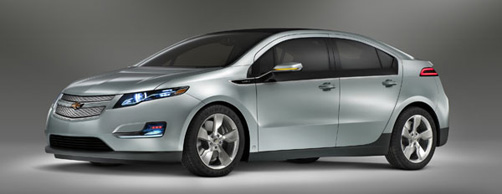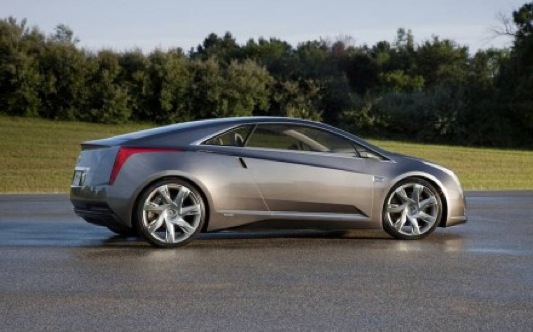




I don’t often root for Chevrolets. Growing up, I witnessed the Citation, Beretta, Chevette, Vega, and Cavalier. The impression left on my generation was one of malaise, contempt for the sucker customer, and an emphasis on slick marketing over sound engineering.
But times change. This is the age of the new Malibu, Camaro, Cruze, Traverse, and most importantly, the Volt.

The Volt was conceived and developed several years before GM’s bankruptcy on a paper napkin in Bob Lutz’s office. Though President Obama wrongly takes credit for bailing out GM, the Volt was not created by Democrats or the Obama administration. The bailout itself (with which I have several practical and ideological disagreements) was initiated and conceived during Bush’s final months in office, then carried out by the Obama administration.
Additionally, prior to GM’s bankruptcy, Democrats and members of the mass media unfairly maligned General Motors for being “anti-green” despite Chevrolet’s fleet being more fuel efficient than Toyota’s. It seems contradictory for Democrats to call themselves GM’s saviors and champions when they spent years maliciously and unfairly trashing Detroit.
Republicans, meanwhile, have turned the Volt into a political football, with commentators like Rush Limbaugh exaggerating its flaws and blaming the president for backing the company and vehicle. It’s quite a change from decades of history when Chevrolet was a brand favored by blue-collar conservatives in middle America. Is “Joe the Plumber” going to buy a Nissan now?
After a crash test, the NHTSA left the volt upside down in a yard with its batteries still installed. After two weeks of being left that way, the Volt’s battery cooling fluid found its way into the cells which then caught fire. GM issued a safety recall but realistically, there was no hazard at all to the driver. NHTSA drains gasoline from its vehicles before impact but neglects to do the same with batteries prior to crash testing.
Unless you routinely park wrecked electric cars upside down in your garage for weeks at a time, this is not a concern.
Republicans and electric car detractors in the media used this incident as a reason to deem the Volt unsafe despite its 5-star safety score.
Fox News Channel’s Eric Bolling received a Volt for evaluation and criticized its 26-mile electric range.
A member of the Fox panel goes on to say “I’d rather rolling skate through the Lincoln Tunnel than break down.”
She was clearly wrong — the Volt does not “break down” after it depletes its battery pack.
Bolling himself said that after 26 miles the car switched to gasoline power, though that isn’t entirely accurate either. The car continues to be propelled by its electric motor while the gas engine comes on to serve as an electrical generator at city speeds, maintaining a steady RPM until the fuel tank is empty, typically after about 250-300 miles.
True and false. The sticker price is $39,145 but federal incentives bring the final cost down by $7500. Some states offer additional credits and Californians can apply for single-occupant HOV lane access.
A GM lease program with $2499 due at signing is only $349 per month for three years, a total of $15,000. If you commuted daily with all-electric power (12,000 miles/year) and used only two tanks of gas per year, you could save approximately $4500 in gasoline at $4 per gallon, including the cost of electricity.
Chevy Volt’s three-year operating cost not including maintenance: $15000 + $500 gas = $15,500
For this to be cost-effective, the Volt would have to be an alternative to another leased vehicle.
An Infiniti G25 sedan can be leased for $299/mo with $3298 down. Over a 39 month lease term, that’s also about $15,000. You would gain a nicer interior and achieve 20/29 mpg city/highway. The Volt, without charging at all, is still capable of 37 mpg. The G25 may average around 25mpg in combined driving. Let’s assume a typical 12,000 miles a year and $4 per gallon of gasoline.
Infiniti G25’s three-year operating cost not including maintenance: $15000 + $6000 gas = $21,000
The Volt is expensive up front but over time it does reduce oil consumption. Of course, compared to a low-cost traditional economical car like the Chevy Cruze, the Volt can’t compare on total ownership costs, at which point it becomes more of a luxury tech novelty than a practical vehicle for most Americans.
The Volt is a tough sell as bargain-basement transportation, but it certainly isn’t as expensive to the consumer as it initially appears and its features and technologies justify most of the price tag. Unfortunately, some of its cost savings are charged to us, the American taxpayers, by the force of the federal government, and those savings may not be permanent depending on future legislation. As a free-market libertarian, it rubs me the wrong way.
The truth, for this myth, is in the middle.

GM certainly deserves blame for the Volt’s souring image. Advertisements like this assume a level of idiocy among consumers:
Fast Tube by Casper
Additonally, the Volt’s access to California’s HOV lanes was delayed by several months due to the lack of a low emissions package. It was a baffling decision by GM as hybrids tend to be sold first in California followed by the other 49 states. California is, by far, America’s largest market for hybrid cars thanks to the state’s predictably mild weather (good for battery life), high fuel costs, and low-emission requirements for HOV access — essential in congested metro areas like Los Angeles. It was a botched launch in a critical market for alternative propulsion.
Only recently has GM offered 0% 60-month financing, a choice it should have made at the very beginning to move units and achieve scale savings for Voltec technology.
Additionally, Voltec should have been introduced in a Cadillac, not a Chevrolet, with upscale styling and a posh interior expected of a $40,000 car. With Chevrolet branding, consumers are inclined to make comparisons to the Cruze and Elantra rather than other luxury cars.
If Cadillac is GM’s flagship brand and Voltec is GM’s flagship technology, why not begin with a Cadillac ELR and later on, once savings are achieved, trickle the technology down to Chevy?

Marketing blunders and politics aside, the Volt is brilliant technology in a comfortable, quiet car that’s actually pleasing to drive.
I totally agree that this should have been packaged as a Cadillac to start with. Bringing it down to the Chevy brand later on would make buyers feel like their getting a luxury feature at a Chevy price point. Also with the rebates it would sway more people to consider the Cadillac over the other luxury brands out there.
To be totally fair, what people don’t feel well about with Obama and and Chevy is not just the money. The administration took the reigns of the company and ultimately the bankruptcy, which was supposed not happen when the government gave them huge amounts of money. Kind of like when I had gained a bunch of weight and if someone gave me more food for free, I would have just gotten heavier. I instead had to start taking control of my eating habits, which were piss poor, and change my lifestyle.
The cost of the car is not the problem with it. It has to compete with and be a better all around car than this list of cars at that price. http://www.automall.com/prices/2012/35000/40000/page/1/price/ Does it succede?
Now, My personal belief is that if e-cars are going to make it, it’s going to be with this sort platform where it can be charged the old fashion way, on the road. The volt is far more likely to be looked at as ahead of it’s time, which in the end does kind of suck. Electric motors for cars can be made to be an awesome compliment to driving over our combustion lumps of right now. R/C cars with brushless motors have performance that is just awesome, that’s what I want from my e-cars personally, so your Cadillac up there would be just fine by me… If they can sell it without needing the government to pay for any of it to bring it into the competitions price range that is 😀